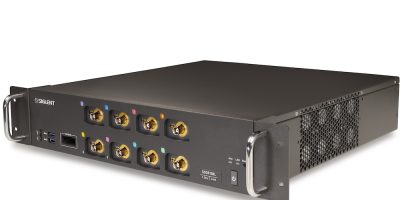Cascadable compact oscilloscopes by Siglent extends SDS6000A range
In order to validate the operation of computers and communication systems, development and text engineers must validate how subsystems interact with multiple programs.
It is almost always necessary to acquire and analyse more than four signals, said Siglent, which has introduced a series of oscilloscopes with a high bandwidth for acquiring very dynamic signals.
The SDS6000A oscilloscopes are available as four- and eight-channel versions without a display. The compact form factor (four-channel device: 1 HU, eight-channel device: 2 HU) saves rack space when integrated into the measurement system Several of these devices can be switched to form a multi-channel system. Connecting an external monitor and a mouse allows the oscilloscopes to be used as stand-alone scopes.
The web server from other Siglent devices is also available, so that the devices can be controlled remotely without external software. The SCPI command structure forms the basis for user-defined programming. Control can be via USB or Ethernet (1000BaseT).
The series offers a maximum bandwidth of 2GHz and the sampling rate is 5Gsample per second per channel. This provides the prerequisite for the acquisition of fast clocks and signals with steep edges. The input stage is optimised for the SDS6000A series and enables signal acquisition with high signal integrity. The SFDR is above 45dBc, with channel-to-channel isolation of up to 70dB. In addition, the DC amplifier accuracy is ±1.5 per cent to assist in analysing small signals in the smallest vertical adjustment range of 500 microV.
The high resolution function allows the vertical resolution to be mathematically improved from eight to 16bits to improve the accuracy of signals captured. For detailed analysis, acquired signals can be zoomed in both the X and Y directions.
The acquisition memory is 500Mbytes and is divided into one, two or four channels. A second memory with a further 500Mpoints is built into the eight-channel device. The waveform capture rate can reach up to 750,000 waveforms per second in sequence mode. In this way, the blind time can be kept short and rarely occurring signals can be found more quickly. The digital trigger and the many different trigger types help to isolate errors in the signal quickly and efficiently. The zone trigger offers a particularly large amount of flexibility, said Siglent. Further signal analysis can be carried out with the large number of implemented measurement functions. Four math channels and an extensive formula editor are available for complex calculations. A flexibly configurable mask test is available as standard for fast pass-fail measurements, for example in the production environment.
The history function, Bode plot and a range of serial bus decoders (I2C, SPI, UART, CAN, LIN) are included as standard with this series. Other serial bus decoders (CAN-FD, FlexRay, MIL1553, I2S, SENT, Manchester) are available and, like the built-in function generator (25MHz), can also be activated later. Other functional additions are eye diagram and jitter analysis to support the developer in the analysis and optimisation of digital data signals.




